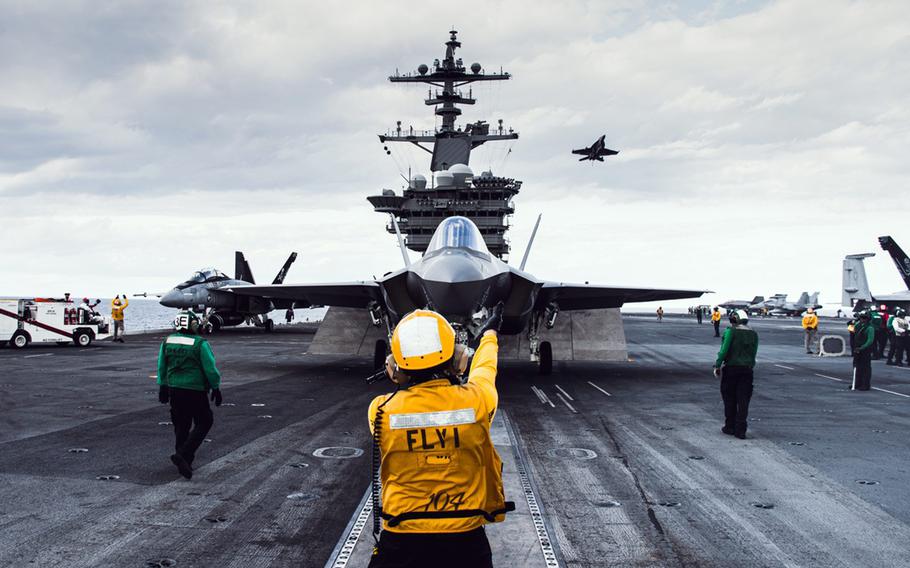
A sailor handles an F-35C Lightning II from Strike Fighter Squadron 147 on the flight deck of the aircraft carrier USS George Washington Dec. 5, 2023. (August Clawson/U.S. Navy)
MARINE CORPS AIR STATION IWAKUNI, Japan — The Navy said Monday it is replacing squadrons of F/A-18 Super Hornet fighters and C-2A Greyhound transports with next-generation stealth fighters and tiltrotors at this base south of Hiroshima.
The F-35C Lightning IIs of Strike Fighter Squadron 147 will replace the F/A-18s of Strike Fighter Squadron 115, according to a news release from U.S. Naval Forces. Likewise, CMV-22B Ospreys with Fleet Logistics Multi-Mission Squadron 30 will swap out with the Greyhounds of Fleet Logistics Squadron 30.
The upgrades in Navy fighter and transport aircraft based in Japan follow a similar move announced July 4 by the Air Force to permanently base 36 F-15EX Eagles at Kadena Air Base, Okinawa, and 48 F-35A Lightning II fighters at Misawa Air Base in the north. Those aircraft replace older model F-15s at Kadena and F-16s at Misawa.
The two Navy squadrons will join Carrier Air Wing 5, which is based at MCAS Iwakuni. The Navy did not lay out a timeline for the aircraft’s arrival in Japan.
The air wing is attached to Carrier Strike Group 5, which will embark aboard the carrier USS George Washington when it arrives at Yokosuka Naval Base, Japan, to replace the USS Ronald Reagan. The Ronald Reagan is returning to Bremerton, Wash., after nine years at Yokosuka.
The Greyhounds shuttle personnel and cargo from ship to shore but were scheduled for replacement by the Osprey, which has increased range, faster cargo loading and unloading, aerial refueling capability and other improvements, according to the Navy.
The crash in November of an Air Force Osprey in southern Japan, killing all eight aboard, delayed that move and stretched the 15 remaining Navy Greyhound’s service several more months, USNI News reported in February.
The 400 Ospreys in the Navy, Marine Corps and Air Force, although cleared to fly in March, are not permitted to fly their full range of missions until mid-2025, Vice Adm. Carl Chebi, who leads U.S. Naval Air Systems Command, told House lawmakers last month.
Strike Fighter Squadron 115 and its F/A-18s arrived at MCAS Iwakuni in November 2017 when the carrier air wing relocated from Naval Air Facility Atsugi, south of Tokyo.
The Marine Corps has two squadrons of F-35Bs, the short-takeoff, vertical-landing version of the stealth fighter, based at MCAS Iwakuni and the Navy has another two squadrons of Super Hornets there with the carrier wing.
The F-35C variant is the Navy’s first long-range stealth fighter built to operate from an aircraft carrier.
“The F-35C is the most capable fighter in the U.S. Navy and the backbone of air superiority; it complements the carrier strike group with a dominant, multi-role, 5th generation aircraft that enhances U.S. power projection and deterrence,” the Navy release states.